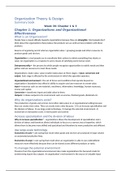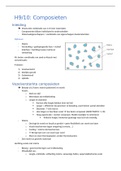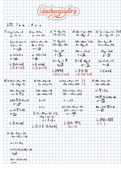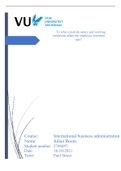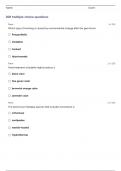Summary book
Week 36: Chapter 1 & 3
Chapter 1: Organizations and Organizational
Effectiveness
What is an Organization?
People have a casual attitude towards organizations because they are intangible. Most people don’t
think about the organizations that produce the products we use until we have problem with those
products.
Essence of organizing and of what an organization does = grouping people and other resources to
produce goods and services.
Organization = a tool people use to coordinate their actions to obtain something they desire or
value. An organization is a response to and a means of satisfying some human need.
Entrepreneurship = the process by which people recognize opportunities to satisfy needs and then
gather and use resources to meet those needs.
Organizations create value, value creation takes place at three stages = input, conversion and
output. Each stage is affected by the environment in which the operation operates.
Organizational environment = the set of forces and conditions that operate beyond an
organization’s boundaries but affect its ability to acquire and use resources to create value.
Input = resources such as raw materials, machinery, information, knowledge, human resources,
money and capital.
Conversion = transforms inputs and adds value to them.
Outputs = release outputs to its environment such as services, finished goods, dividends etc.
Why do organizations exist?
The production of goods and services most often takes place in an organizational setting because
they can create more value. They can create more value because: 1) it can increase specialization and
the division of labour, 2) use large-scale technology. 3) manage the external environment. 4)
economize on transaction costs. 5) exert power and control.
Increase specialization and the division of labour
Why to increase specialization? = organizations allows the development of specialization and a
division of labour and therefore allows individuals to focus on a narrow area of expertise, which
allows them to become more skilled and specialized and therefore be more productive and efficient.
Use large-scale technology
Economies of scale = cost saving that result when goods and services are produced in large volume
on automated production lines.
Economies of scope = cost saving that result when an organization is able to use underutilized
resources more effectively because they can be shared across different products or tasks.
To manage the external environment
Pressires from the organizational environment also make organizations the favoured mode for
transforming inputs into outputs. An organization’s environment is the source of valuable input
,resources and is the marketplace into which it releases outputs. It is also the source of economic,
social and political pressures that affect an organization’s ability to obtain these resources. An
organization has the resources to develop specialists to anticipate or attempt to influence the
pressures from the environment. This specialization allows the organization to create more value.
To economize on transaction costs
Transaction costs = the cost associated with negotiating, monitoring and governing exchanges
between people.
To exert power and control
Organizations can exert pressure on individuals to conform to task and production requirements. Al
these requirements make production less costly and more efficient but put a burden on individuals.
Organizational theory, design & change
Organizational theory = the study of how organizations function and how they affect and are
affected by the environment in which they operate. First step in learning how to control and change
organizations so that they can create wealth and resources effectively.
Organizational structure = The formal system of task and authority relationships that control how
people coordinate their actions and use resources to achieve organizational goals. The principal
purpose is one of control to control the way people coordinate their actions to achieve
organizational goals and to control the means used to motivate people to achieve these goals.
Organizational culture = The set of shared values and norms that controls organizational members’
interactions with each other and with suppliers, customers, and other people outside the
organization. An organizational culture is shaped by the people inside the organization, the ethics
of the organization, by the employment rights given to employees and by the type of structure used
by the organization. Like structure, it shapes and controls behaviour within an organization.
Organizational design = the process by which managers select and manage aspects of structure and
culture so an organization can control the activities necessary to achieve its goals. Therefore,
organizational structure & culture are the means the organization uses to achieve its goal. The design
is manager’s top priority because of increased global competitive pressures and increasing use of
advanced IT; constantly searching for new and better ways to produce goods or services.
Organizational change = the process by which organizations redesign their structures and cultures to
move from their present state to some desired future state to increase their effectiveness. The goal is
to find new or improved ways of using resources and capabilities to increase the organization’s ability
to create value.
Contingencies (= onvoorspelbaarheid) = An event that might occur and must be planned for, for
example a new competitor, government increase, customers change, globalization, changing
technology. The organization’s design determines how effectively an organization is able to respond
to various pressures in its environment. Organization’s design determines how effectively an
organization is able to respond to various pressures in its environment and so obtain scarce
resources.
Competitive advantage = The ability of one company to outperform another because its managers
are able to create more value from the resources at their disposal.
Core competences = Managers’ skills and abilities in value-creating activities such as manufacturing,
R&D, managing new technology, or organizational design and change. These competences allow a
,company to develop a strategy to outperform competitors and produce better products (or products
at a lower cost). However, many core competences are temporarily as they are easy to imitate.
Strategy = The specific pattern of decisions and actions that managers take to use core competences
to achieve a competitive advantage and outperform competitors.
Managing Diversity
Differences in race, gender, and national origin of organizational members have important
implications for the values of an organization’s culture and for organizational effectiveness. Create an
organizational design to make optimal use of the talents of a workforce and encourages people to
work together.
The Consequences of Poor Organizational Design
Organizational structure and culture control behaviour, managers are often unaware of the many
factors that affect this relationship, paying scant attention to the way employees behave and their
role in the organization, until something happens.
Managers easily lose control of their organizational structures and cultures. This can results in
talented employees leaving, resources become harder to acquire, slowing down the value creation
process.
How do managers measure organizational effectiveness?
Control, innovation, and efficiency are the three most important processes managers use to assess
and measure how effective they, and their organizations, are at creating value.
Control = having control over the external environment and having the ability to attract resources
and customers.
Innovation = means developing an organization’s skills and capabilities so the organization can
discover new products and processes. It also means designing and creating new organizational
structures and cultures that enhance a company’s ability to change, adapt, and improve the way it
functions.
Efficiency = means developing modern production facilities using new information technologies that
can produce and distribute a company’s products in a timely and cost-effective manner. It also means
introducing techniques to improve productivity (like inventory systems, quality management).
Managers can take one of the three approaches to evaluate the effectiveness; see table:
Approach Description Goals to Set to Measure
Effectiveness
External resource approach Evaluates the organization’s - Lower costs of inputs
ability to secure, manage, and - Obtain high-quality inputs of
control scarce and valued skills raw materials and employees
and resources - Increase market share
- Increase stock price
- Gain support of stakeholders
such as government or
environmentalists
Internal systems approach Evaluates the organization’s - Cut decision-making time
ability to be innovative and - Increase rate of product
function quickly and innovation
responsively - Increase coordination and
, motivation of employees
- Reduce conflicts
- Reduce time to market
Technical approach Evaluates the organization’s - Increase product quality
ability to convert skills and - Reduce number of defects
resources into goods and - Reduce production costs
services efficiently - Improve customer service
- Reduce delivery time to
customers
External resource approach = secure scarce and valued skills and resources fom outside the
organization. A method managers use to evaluate how effectively an organization manages and
controls its external environment.
Internal systems approach = coordinate resources with employee skills creatively to innovate
products and adapt to changing customer needs. A method that allows managers to evaluate how
effectively an organization functions and resources operates.
Technical approach = convert skills and resources efficiently into finished goods and services. A
method managers use to evaluate how efficiently an organization can convert some fixed amount of
organizational resources into finished goods and services.
Measuring effectiveness: organizational goals
Official goals = guiding principles that the organization formally states in its annual report and in
other public documents. Usually these goals lay out the mission of the organization: they explain why
the organization exists and what is should doing.
Operative goals = specific long- and short-term goals that guide managers and employees as they
perform the work of the organization.


